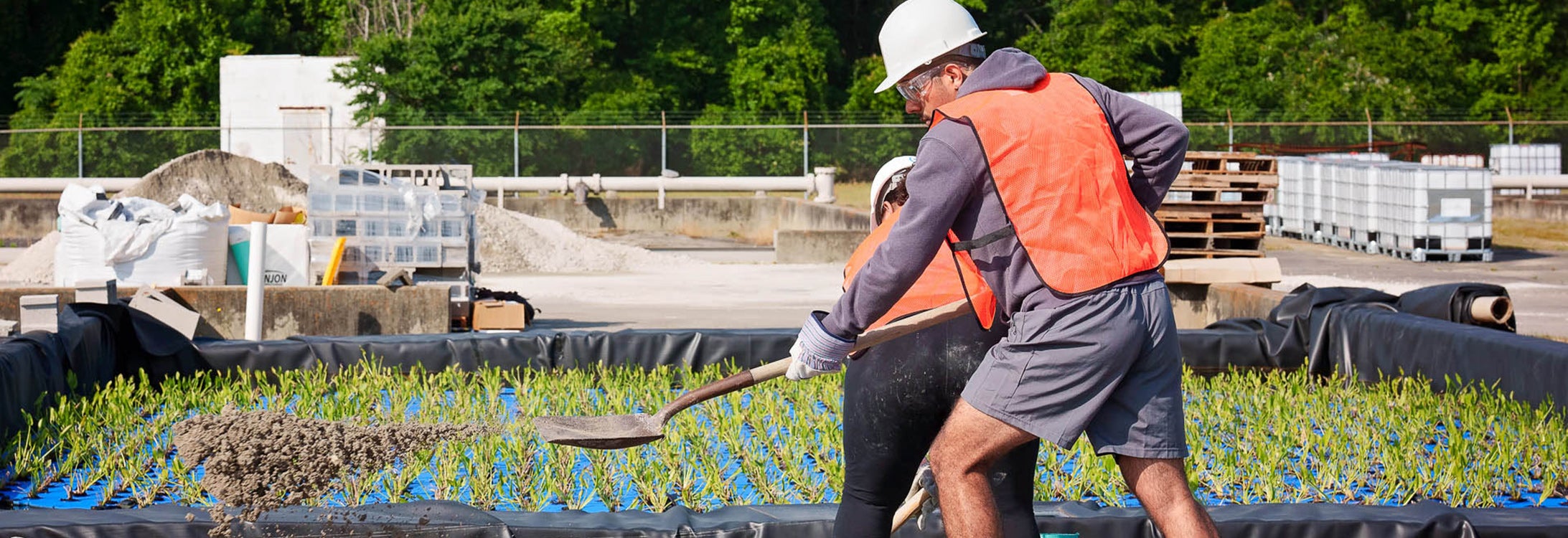TREATMENT PLAN
ECU researchers create wetland to rid wastewater of problem nutrients
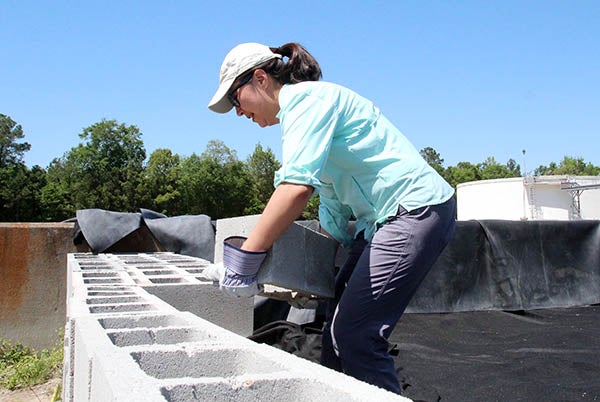
Dr. Natasha Bell, assistant professor in the Department of Engineering, places a block that will help form the wall of one of the wetland cell basins. (Photo by Ken Buday)
Dressed in a neon orange vest and hard hat, East Carolina University engineering student Ariel Lineberger grabs a shovel, spreading gravel that will be the base of a pool in which no one should swim.
“The manual labor has been tough but rewarding,” Lineberger said.
The pool is part of an innovative hybrid constructed wetland system at the Greenville Utilities Commission (GUC) wastewater treatment plant that is designed to help remove nitrogen and phosphorus from wastewater. The nutrients, in high levels, can harm the environment.
Dr. Natasha Bell, an assistant professor in ECU’s Department of Engineering, received a $1.2 million University of North Carolina System Research Opportunities Initiative (ROI) grant designed to strengthen the resiliency of wastewater infrastructure throughout the state. North Carolina Sea Grant has also contributed funding.
“A hybrid constructed wetland is a newer type of treatment wetland that utilizes treatment cells that go in a series,” Bell said. “Each of the treatment cells performs a different function. It enables all the different processes that need to happen for nitrogen and phosphorus to ultimately be removed.”
A pre-treatment cell includes course gravel filters to screen out solids, with a pump system sending the water to the next cell where a bed consisting of zeolite — minerals that contain mainly aluminum and silicon compounds used for absorption — will remove ammonium, followed by a crushed concrete bed that will adsorb phosphate. A woodchip bioreactor aims to turn nitrate into inert nitrogen gas, and the final polishing cell includes floating treatment wetland plants to help further reduce the amount of nitrogen and phosphorus in the water.
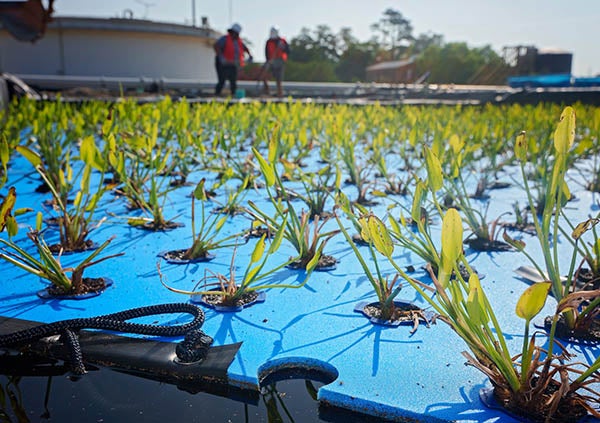
Floating treatment wetland plants in a cell basin are designed to reduce the amount of nitrogen and phosphorus in wastewater. (Photo by Cliff Hollis)
Bell said high levels of nitrogen and phosphorus have been known to spark algal blooms in waterways. As the algae die, microbes break down the algae, using the oxygen in the water that fish need to live, thus creating fish kills. Algal blooms also release neurotoxins that can harm pets and people.
“It’s a human health concern too, not just an ecological concern,” Bell said. “And it all comes down to economics too. Harmful algal blooms have impacted waterfront properties, the shellfish industry and drinking water sources, so there are a large number of potential impacts downstream from too much nitrogen and phosphorus.”
Helping the community
The project is one of several in which ECU has partnered with GUC, including a 2019 senior capstone that explored the feasibility of using treated wastewater in waterfowl impoundments.
Jason Manning, superintendent of the wastewater treatment plant, said the wetland project has benefits beyond increased nutrient removal from the effluent.
“The proposed solutions we are testing will not increase our annual operating budget or require a great deal of capital investment. This is a huge win for GUC’s customers,” he said. “The proposed solution will create a plan to construct wetlands that will also provide a learning opportunity for ECU students in environmental studies and ecology for years to come.”
Manning said Bell and others at ECU have been quick to respond to questions and provide feedback on GUC proposals and ideas, adding to a “mutually beneficial partnership” that he believes other industries should take advantage of to solve problems.
“Working with Dr. Bell and her students has been very positive,” he said. “I and my staff are learning from them and applying the academic knowledge shared to our business and treatment processes. This effort emphasizes the importance of excellent, sustainable and resilient wastewater treatment for our community.”
Helping students
Engineering student Daniel Franklin works in a small room in ECU’s Life Sciences and Biotechnology Building. In the windowless lab, he can’t even see outside, let alone think about the cell basin at the wastewater treatment plant. He’s working on monitoring and control systems that will sample the wastewater automatically and send that data to the researchers.
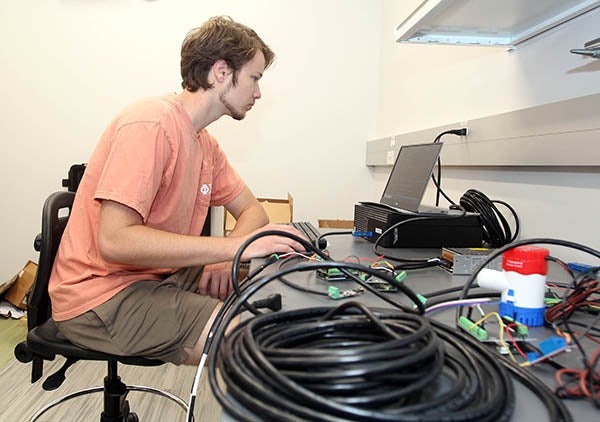
Engineering student Daniel Franklin works on the monitoring and control systems for the wetland system in a lab in the Life Sciences and Biotechnology Building. (Photo by Ken Buday)
A junior seeking engineering degrees with concentrations in both mechanical and electrical engineering, Franklin said the work he’s been doing on the project has provided him opportunities to use what he’s learned in the classroom as well as to learn on his own.
“I knew a little bit about Arduino (an open source software platform used in electronics) from my coursework but I’m learning more about that, and I’m learning some Python coding,” he said. “I’m really getting to practice the design process, and I’m getting to work in a professional environment.”
Beyond that, the Greenville native knows the project has meaning, even if he never sees the finished product.
“I always wanted to use my engineering degree in a STEM field as a way to do something positive in a local community,” Franklin said. “… I don’t know exactly what the environmental impacts might be, but I know the work is being put to good use, and I enjoy being part of something like that.”
Lineberger, whose concentration is in environmental engineering, also sees the value in the hard work she has put into the project.
“Coming from the mountains of North Carolina, I have always seen the value of having mutualism between nature and humans,” said Lineberger, who grew up in Nebo. “This comes in different forms, but in this project, mutualism is seen through providing nutrient rich wastewater to microbial processes and plants. I feel like I am honoring that symbiotic relationship by being a part of this project, and it shows me that others are trying to change the scope of anthropogenic effects.”
The project includes more than 15 undergraduate and graduate students from engineering, chemistry, biology and geology as well as doctoral students in the integrated coastal studies program and the interdisciplinary program in biology, biomedicine and chemistry. Faculty from those departments are also involved.
As another part of the project, Lineberger has worked with Raleigh-based Natrx Adaptive Infrastructure to develop and test 3D-printed materials designed to capture nutrients.
But on a warm and sunny day, she and others worked up a sweat preparing a cell basin.
“Seeing the wetland cell completed truly put it all into perspective,” she said. “It was cool to see the progress unfold.”
She said she’s proud to be part of the team.
“There are great people doing great things, and it is enlightening to see projects like this,” Lineberger said.
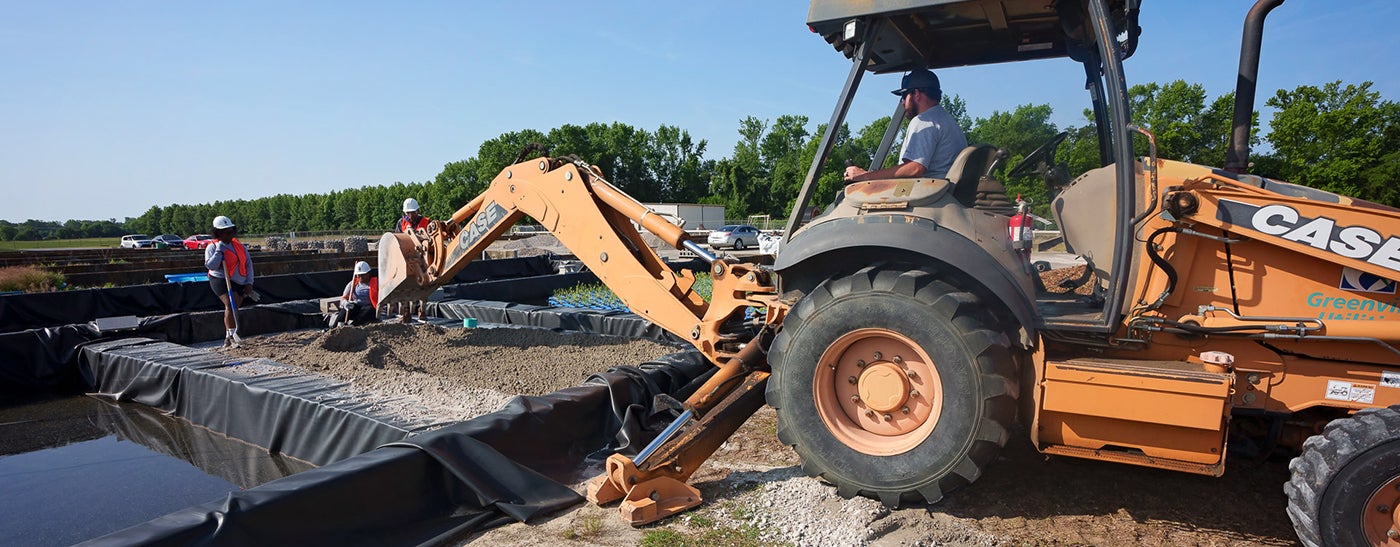
ECU students work to create a hybrid constructed wetland system at the Greenville Utilities Wastewater Treatment Plant. (Photo by Cliff Hollis)
MORE STORIES
